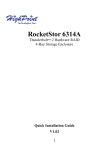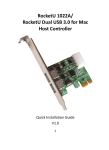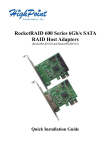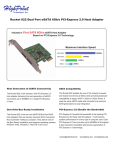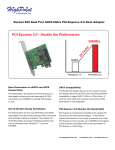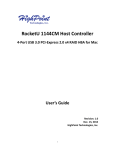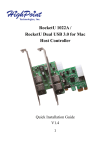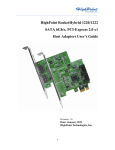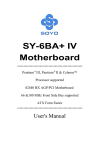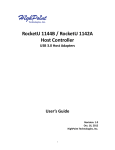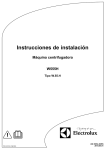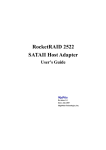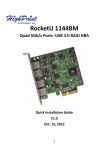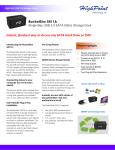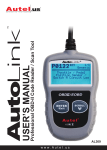Download RocketStor 6314A User Manual
Transcript
RocketStor 6314A
User Manual
Sept. 25, 2015
Revision v1.02
HighPoint Technologies, Inc.
1
Copyright
Copyright © 2015HighPointTechnologies, Inc. This document contains
materials protected by International Copyright Laws. All rights reserved. No
part of this manual may be reproduced, transmitted or transcribed in any form
and for any purpose without the express written permission of HighPoint
Technologies, Inc.
Trademarks
Companies and products mentioned in this manual are for identification
purpose only. Product names or brand names appearing in this manual may or
may not be registered trademarks or copyrights of their respective owners.
Backup your important data before using HighPoint's products and use at your
own risk. In no event shall HighPoint be liable for any loss of profits, or for
direct, indirect, special, incidental or consequential damages arising from any
defect or error in HighPoint's products or manuals. Information in this manual
is subject to change without notice and does not represent a commitment on
the part of HighPoint.
Notice
Reasonable effort has been made to ensure that the information in this manual
is accurate. HighPoint assumes no liability for technical inaccuracies,
typographical, or other errors contained herein.
2
Contents
Kit Contents .......................................................................................................................................................5
Getting Started ..................................................................................................................................................8
Setting Up the Hardware .............................................................................................................................8
Install and Update Drivers ....................................................................................................................... 14
Install/Update Drivers on existing operating systems .................................................................. 16
Creating a Bootable Array (Mac Only) ............................................................................................... 22
Installing HighPoint WebGUI ................................................................................................................... 22
Navigating the WebGUI ................................................................................................................................. 24
Logging In HighPoint WebGUI ................................................................................................................. 25
Global Tab ................................................................................................................................................... 27
Viewing HBA Properties ....................................................................................................................... 28
Viewing Storage Properties.................................................................................................................. 28
Physical Tab ................................................................................................................................................ 29
Updating BIOS/Firmware ..................................................................................................................... 30
Obtaining Physical Device Information ............................................................................................ 30
Logical Tab .................................................................................................................................................. 33
Creating an Array .................................................................................................................................. 33
Adding Spare Disks ............................................................................................................................... 38
Obtaining Logical Device Information .............................................................................................. 39
Expanding an Existing Array ............................................................................................................... 41
Setting Tab .................................................................................................................................................. 44
System Settings ...................................................................................................................................... 45
Changing your WebGUI password ..................................................................................................... 46
Recovering your WebGUI password................................................................................................... 46
Email Setting ........................................................................................................................................... 46
Recover Tab................................................................................................................................................. 48
Backup your Recover List .................................................................................................................... 48
Reloading your Backup Recover List ................................................................................................. 49
Event Tab ..................................................................................................................................................... 49
Event Log Icon Guide ............................................................................................................................ 49
SHI (Storage Health Inspector) ................................................................................................................ 50
Enabling SMART Monitoring ............................................................................................................... 50
Changing HDD Temperature Threshold ........................................................................................... 51
3
Utilizing the Health Inspector Scheduler ......................................................................................... 51
Creating a New Verify Task ................................................................................................................. 52
Initializing your Disks................................................................................................................................... 53
Formatting your Disks .................................................................................................................................. 53
Replacing a Failed Disk ................................................................................................................................. 54
Rebuilding Your Array .................................................................................................................................. 54
Critical Condition ...................................................................................................................................... 55
Rebuilding Interrupted Due to Bad Sectors ..................................................................................... 55
Critical array disabled when you removed wrong disk ................................................................. 56
Disabled Condition .................................................................................................................................... 56
Help ................................................................................................................................................................... 57
WebGUI Icon Guide .................................................................................................................................... 58
RAID Level Reference Table..................................................................................................................... 60
HighPoint Recommended List of Hard Drives ..................................................................................... 61
Contacting Technical Support ................................................................................................................ 61
4
Kit Contents
RS6314A Enclosure (with 4 disk trays pre-installed)
Accessories Box
Screw bag (including 2 sets of 18 screws for HDD/SSD)
Thunderbolt™ Cable
UL Power Cord
Quick Installation Guide for RS6314A
For any damaged or missing items contact your reseller or submit a support ticket online at
www.highpoint-tech.com/websupport/
5
Product Information
RocketStor 6314A
Port Technology
Onboard Storage processor
Onboard Cache Memory
Port Type
RAID Level
Max. Capacity
Number Of drives
Drive Interface
Drive Form Factor
Material
Dimension
Weight
Warranty
Thunderbolt™ 2
RAID-On-Chip Onboard
512MB DDR 3 Cache Memory with ECC Protection
2x Thunderbolt™ Port
0, 1, 5, 6, 10 and JBOD
up to 32 TB
Up to 4
SAS, SATA
3.5" & 2.5"
Brushed aluminum housing
8.66"(H)x5.31"(W)x8.67"(D)
9.46lb
3 Years
Advanced RAID Feature
Configurable RAID Block Size up to 1MB
Flash ROM for Upgradeable Firmware
DV Mode Technology
Storage Health Inspector
Redundant RAID Configurations
Bootable RAID Array
EFI BIOS for Mac Platform
Multiple RAID Partitions supported
Online Array Roaming
Online RAID Level Migration (ORLM)
Online Capacity Expansion (OCE)
RAID Initialization Background/Foreground/Quick
Global Hot Spare Disk support
Automatic and configurable RAID Rebuilding Priority
Disk Format compatible: 512, 512e, 4Kn
Larger than 2 TB Drive and RAID Array support
Spin down Massive Arrays of Idle Disks support
Native Command Queuing
Write Back and Write Through
Storage Monitoring and Management Suite
RAID Management Suites:
Drive Indicator
SMTP
Alarm Buzzer
Browser-Based management tool,
Power, Present, Active, Fail
Email Alert Notification
Buzzer beeping when failed drive or array occurs
Operating System
Window 2008 and Window 7 and later
Driver embedded into Mac OS X 10.9 and later
Power Supply
AC INPUT 100-240V ~ 5A 50/60Hz
6
Operating Environment
Temperature
Relative Humidity
(operating) 5°C – 45°C
(non-operating) -40°C – 65°C
(operating) 8% – 90% RH (Non-condensing)
(non-operating) 5% – 95% RH (Non-condensing)
Figure 1. RS6314A Front Panel
Figure 2. RS6314A Back Panel
Figure 3. Isometric view of disk tray with physical drive installed (drive not included)
Figure 4. Bottom View of disk tray. SSD mount points are on the bottom.
7
Getting Started
Thank you for purchasing HighPoint Technologies RocketStor 6314A. You are only a few steps
away from utilizing RAID storage using the industry’s most affordable hardware RAID solution.
Main topics in this section include:
Setting Up the Hardware
How to Update and Install Drivers
How to Install HighPoint WebGUI
Setting Up the Hardware
Important:
1. Ensure that you have all items listed under Kit Contents.
2. Verify and record the S/N of the enclosure unit.
The technical support may ask for the S/N of the enclosure unit. Please record the S/N of
the unit. The S/N is located on the sticker on the bottom of the enclosure unit as below.
The S/N has 13 characters and the S/N format for the RocketStor 6314A is “****M3M******”
8
Setup the hardware
Step 1. Plug in the power cord for your RS6314A. Note: To prevent physical drive damage, keep
the RS6314A oriented upright when in use.
Figure 5. Power Cord plugged into back panel
Step 2. Plug one end of the Thunderbolt™ cable to either of the RS6314A ports and the other
end to your computer’s Thunderbolt™ port.
Figure 6. Connect to either the right or left Thunderbolt™ port.
Step 3. Press then pull the blue tab on each disk tray to unlock and slide out each tray.
Step 4. Mount your hard drives onto each tray using the provided screws. (Note: see HELP for a
list of recommended hard drives)
Step 5. The disk trays have pre-drilled holes compatible with 3.5” and 2.5” hard drive form
factors. SSD holes are drilled on the bottom of the disk tray.
9
Step 6. Switch the power button on.
Figure 9. Power Button located on Back Panel (figure shows enclosure switched ON)
Step 7. Make sure the power LED on the front of the enclosure is LIT.
Step 8. (For Windows) Install RS6314A drivers and the HighPoint WebGUI Management Utility
to access and manage your arrays.
(For Mac) RS6314A drivers are pre-installed for Mac OSX 10.9 and later. Earlier versions of Mac
OSX may require driver installation
LED Activity
A quick, convenient way for identifying a faulty drive or enclosure unit is to read the LED lights
on the front panel.
Table 1. LED Activity Reference
LED Location
Disk Tray Top
LED
Icon
Normal
When powered
on, the LED will
be a STABLE
BLUE
When disk is
busy, the LED
will be BLINKING
BLUE
10
Faulty
Disk Tray Bottom
LED
When array is
normal status,
LED will be
UNLIT
Power LED
When enclosure
is powered on
LED will be
SOLID BLUE
Power LED will
be UNLIT if not
connected to a
running host
system
When disk has a
problem, LED
will be SOLID
RED
When disk is
under
Rebuilding, LED
will be Blinking
RED
Table 2. LED Status Information
LED Status
STABLE BLUE
Interpretation
BLINKING BLUE
RED
Disk is detected and connection has been
made
Enclosure is properly powered
Disk is in use and performing I/O activity
such as:
Rebuilding an array
Verifying data integrity
Transferring data
Turned Identify LED ON
Disk communication failure potential causes:
Disk is unplugged
Disk array is in critical condition
Disk array is in disabled condition
SMART detected disk failure
11
UNLIT
Unit is powered OFF
Disk tray is empty
Shutting Down the RS6314A
The 6314A enclosure will automatically power down when your computer is turned off. For
turning off the 6314A safely without shutting down your PC, take the following steps:
1. Eject the drive from OSX
Right Click the drive and click Eject
Double click the drive and click the Eject button for the drive under devices
2. Check the front panel LED lights to make sure there is no disk I/O activity
3. Switch the power switch on the back panel OFF (O is pushed down) or unplug the
Thunderbolt™ cable.
Important: Do not move or tilt the enclosure until disk activity has completely stopped to
prevent physical damage of hard drives.
Daisy Chaining the RS6314A
Daisy chaining means you are connecting multiple devices in a series in an effort to expand
your storage without using more PC ports. Up to 6 Thunderbolt™ devices can be daisy chained
together.
Figure 7. Sample daisy chain configuration.. RS6328L connected to RS6314A connected to
another RS6314A (left to right)
1. Plug in one end of Thunderbolt™ cable to your Mac, and the other end to a RS6314A
Thunderbolt™ port.
2. Plug in one end of another Thunderbolt™ cable into the unused port, and the other end of
the cable into the next Thunderbolt™ device.
Note: Wait at least 20 seconds for the device to be detected by the system.
Important: Chaining SIX RS6314A enclosures DOES grant you access of up to 24 hard drives,
but DOES NOT allow you to create a single RAID array using all 24 drives. Each RS6314A
enclosure has its own RAID controller that detects only the 4 hard drives connected to it.
12
13
Install and Update Drivers
Drivers provide a way for your operating system to communicate with your new hardware.
Update to the latest driver to ensure you have the latest performance and stability updates.
Check if drivers are currently installed
For Mac users:
1.
2.
3.
4.
5.
Click on the Apple Icon (
Click About this Mac
Click More Info
Click System Report
Select PCI Cards
Figure 8. Navigate to Apple Icon > About this Mac > System Report > PCI
The RS6314A should be listed as RocketRAID 4520 SAS Controller, and Driver Installed should
say Yes. (HighPoint Mac drivers are embedded for OSX 10.9 and later.)
For Windows users:
1.
2.
3.
4.
5.
Install and verify motherboard Thunderbolt™ drivers are functional
Click Start
Click Control Panel
Click Hardware and Sound
Under Devices and Printer, Click Device Manager
14
Note: Alternatively, you can search Device Manager in your start menu search bar.
6. Click the Storage controllers tab
If driver is installed it will show RocketRAID 4520 SAS Controller,
If driver is not installed it will be located in Other devices as RAID Controller
15
Click Properties, then click the Driver Tab to find out the version installed.
Figure 9. Driver version 1.4.74.22 (version may vary)
Install/Update Drivers on existing operating systems
For users that already have an operating system installed, and want to use the RS6314A as a
data array (data storage) device, follow the instructions below.
For users that wish to create a bootable array, refer to Create a Bootable Array
For Mac Platforms:
Drivers for RS6314A are already embedded in the latest Mac OSX (10.9 and later), and installing
drivers is unnecessary. If you previously uninstalled the drivers, or wish to update your current
drivers, follow the instructions below.
HighPoint Mac Drivers have file extension .dmg; make sure the file extension for the files you
downloaded are the same.
1. Obtain latest driver online at http://www.hptmac.com/series-rs6314a-resources.php
16
2.
3.
4.
5.
6.
Navigate to your specific HBA controller page (Refer to How to View HBA Properties to
find model name)
Once downloaded, locate the folder you downloaded the driver to and double click on the
file named “HighPointIOP_Mac_###.dmg” Note: File name varies, but extension is .dmg.
The file will be mounted onto the operating system, click on HighPointIOP.pkg located on
your desktop
Follow the on-screen instructions.
Reboot computer
Make sure Driver Installed is Yes
After reboot, check system report again to confirm you have RocketRAID 4520 SAS Controller
installed.
For Windows Platforms:
1. Download the latest drivers from http://www.hptmac.com/series-rs6314a-resources.php
For PC motherboards with Thunderbolt™, download the WHQL driver files
2. Once downloaded, click setup.exe
3. Follow the on-screen instructions until prompted to reboot
17
18
4. After reboot, check drivers are installed properly using device manager
Alternate Install Method:
1. Obtain latest driver software for RocketRAID 4520 SAS Controller from our website
http://www.hptmac.com/series-rs6314a-resources.php
2. Take note the location you downloaded the driver file to, then open Windows Device
Manager.
Click Start
Click Control Panel
Click Hardware and Sound
Under Devices and Printer, Click Device Manager
Note: Alternatively, you can search Device Manager in your start menu search bar.
3. Under Other Devices, right click on RAID controller
4. On the drop down menu, click Update Driver Software…
19
5. When prompted, select Browse my computer for driver software
6. Locate the driver files you downloaded and select them.
7. Press next and follow the on screen instructions
8. Reboot
20
Uninstall Drivers
To uninstall the drivers, take the following steps
For Mac Platform:
1. Double click on “HighPointIOP_Mac_106_####.dmg” Note: File name subject to change,
make sure extension is .dmg.
2. Double click on uninstall.command
3. A terminal window will pop up prompting you to type in your administrator password.
Type in your administrator password to allow uninstall.
4. Reboot
Note: The file is flagged as an unidentified developer file on OSX. In order to open, hold the
Control key + click the file, then click open. A system prompt will appear; read the prompt,
then click open.
For Windows Platform:
1. Open Windows Device Manager
Click Start
Click Control Panel
Click Hardware and Sound
Under Devices and Printer, Click Device Manager
Note: Alternatively, you can search Device Manager in your start menu search bar.
2. Click the Storage controllers tab
3. Right click RocketRAID 4520 SAS Controller
4. Click Uninstall
5. Reboot your PC for changes to take effect
21
Creating a Bootable Array (Mac Only)
A bootable array differs from a data array simply from the fact that you install and boot your
operating system from the RAID array you created.
For Mac Users:
1. You must have an existing installation of the Mac operating system installed.
2. Set up the RS6314A normally by
See setting up the hardware
How to install the WebGUI
How to create an array
3. Once an array is created, the logical volume can be seen by your operating system
4. Use a 3rd party disk cloning tool to copy your bootable drive onto the logical drive you
just created.
For Windows Users:
Booting from Windows is currently not supported on RS6314A.
Installing HighPoint WebGUI
HighPoint Web RAID Management Software (WebGUI) is used to monitor and configure your
hard disks and RAID arrays attached to HighPoint RocketRAID controllers.
The software package must be installed on system with supported HighPoint RocketRAID
controllers installed, and the device driver must be loaded to run the service. A web browser
with XML support is required on the client side, e.g. Internet Explorer, Mozilla, FireFox or
Google’s Chrome.
New features are continually added to the interface; update to the latest version at
http://www.hptmac.com/series-rs6314a-resources.php
1. Locate the HighPoint WebGUI Setup on our website http://www.hptmac.com/series-rs6314aresources.php and download the file
2. Extract the files from the archive
3. Double click on “HighPoint RAID Management.exe”
4. Follow the on screen steps to install our software.
22
5. Log in the WebGUI by double clicking the desktop icon created or by typing
http://localhost:7402 in your preferred browsers address line (it is recommended to use the
latest version of your browser.)
23
Navigating the WebGUI
The HighPoint WebGUI management utility allows you to do several key things:
Create and remove arrays
Monitor disk health
Update firmware and BIOS
Change enclosure settings
Troubleshoot faulty drives
View general system overview
Tab Name
Function
View HBA (Host Bus Adapter) and Storage
Properties
Global View
Physical
View Additional Controller properties
Update BIOS/Firmware
View disk properties
Adjust selected disk behaviors
Logical
Manage and create RAID arrays
Setting
Adjust WebGUI controls settings
Event
SHI (Storage Health Inspector)
Show WebGUI Event Log
View and schedule S.M.A.R.T monitoring
Recover
Revert to previously created arrays
Logout
Logout of WebGUI
Help
Additional WebGUI documentation
Online Web Support
24
Logging In HighPoint WebGUI
You can reach the HighPoint WebGUI log in page either by:
Double clicking on the HighPoint RAID Management icon created on your desktop
Opening your preferred web browser and typing http://localhost:7402 in the address bar.
For the Windows WebGUI, please use the default user name: RAID and password: hpt for log-in.
For the Mac WebGUI, it will log-in without password needed
You can set up the Password from the WebGUI > Setting page.
25
Remote Login
A user connected to a local network can remotely access the WebGUI using the IP address of the
host device.
To obtain your IP address
For Mac users:
1. Open a terminal window on the host computer (computer that is connected to the RS6314A
enclosure)
2. Type ifconfig
3. Look for the connection that has status: active
4. Write the IP address located after inet:
For Windows users:
1.
2.
3.
4.
Open a command prompt window on the host computer.
Type ipconfig
Look for the section that contains your network adapter information
Take Note the IP address
26
Note: Make sure Restrict to localhost access is disabled in WebGUI Setting (Refer to setting)
You can then remotely access the WebGUI using any other computer that is in your local
network by opening any web browser and typing http://{IP address of host computer}:7402
(default port is 7402)
Global Tab
27
The GUI Global view provides an overview of what each HighPoint controller card connected to
your computer detects. It is also the first page you see when logging in.
Host Bus Adapter Properties
Storage Properties
On the top left of the page is a drop down menu that allows you to select which controller you
want to manage (if you have multiple HighPoint controllers connected).
Viewing HBA Properties
1. Log in to WebGUI
2. Select the proper controller from drop down on the top left
3. Click Global View
HBA Properties
Host Adapter model: the model name of the controller
Enclosure Count: number of external enclosures detected
Physical drives: number of drives seen by the controller
Legacy Disks: number of Legacy disks connected. Legacy disks are physical drives that
have previous partitions stored on them.
Viewing Storage Properties
1. Log in to WebGUI
2. Select the controller from drop down menu on top left
3. Click Global View
Storage Properties
Total capacity: the combined capacity of each physical disk connected to controller
Configured capacity: the amount of space used for creating arrays
Free Capacity: total amount of space unused
28
Physical Tab
The physical tab shows general and extended information about the controller you are using.
Information about the firmware, BIOS, and operating temperatures are all located here. This
information is useful for identifying what RAID controller model you have and to make sure
you have the most updated version available.
The physical tab contains the following information:
Controller Information
Extended Information
Update Firmware
Physical Devices Information
Controller Information: Lists the controller model name, BIOS version, and vendor.
Model Name: RocketRAID 4520 SAS Controller (for RS6314A)
EFI Version: v1.1 (as of 5/5/2015)
Vendor: HighPoint Technologies, Inc.
29
Extended Information: Gives you additional information concerning the HBA (Host Bus
Adapter) in the enclosure
IOP Model: IOP chip model number
CPU Temperature: Displays computer temperature in Celcius (°C).
Board Temperature: Displays the board temperature in Celcius (°C).
SDRAM Size: SDRAM size of the HighPoint controller card
Battery Installed: Battery Backup Unit (Not Applicable for RS6314A)
Firmware Version: Firmware version of the HBA
SAS address: the SAS address
Update Firmware: Allows you to update the controller BIOS through the WebGUI.
Updating BIOS/Firmware
Keeping the firmware up to date ensures that your RAID controller the latest compatibility and
performance updates. Firmware files have extension .blf.
1. Locate the latest firmware on our webpage at www.highpoint-tech.com
2. Example firmware file will be in a zipped package with a naming convention such as
RR4520_v1.6.3.0_xxxx.zip
3. Extract the contents of the file
4. Read the readme (if included) to make sure you have the correct firmware for your HBA
Note: Your HBA name and properties can be found in the WebGUI > Physical Tab.
5. Locate the proper firmware file (eg. 4520fw.blf, refer to the readme)
6. Click Choose File and browse to your firmware file
7. Click Submit
8. Reboot
Obtaining Physical Device Information
1. Log in to WebGUI
2. Click Physical
3. Click Devices located on the left panel
30
The following properties are part of the Physical Devices Information box under the physical
tab.
Model – Model number of the physical drive
Capacity – Total capacity of the physical drive
Revision – HDD device firmware revision number
Read Ahead* - (Enable/Disable) Disk read ahead.
Location – Device location (example: 1/2 states controller 1, slot 2)
Write Cache* – (Enable/Disable) the disk write cache
Max Free – space on disk that is not configured in an array
Status – (Normal, disabled, critical) status of the disk
NCQ* – (Enable/Disable) Native Command Queuing
Serial Number – serial number of the physical disk
Identify LED* – On/Off – toggle the IDENTIFY (RED) on the front panel
Unplug – Safely ejects selected disk. Other methods of disk removal will trigger alarm if
enabled.
31
* Disk properties that can be adjusted.
Read Ahead
Enabling disk read ahead will speed up read operations by pre-fetching data and loading it into
RAM.
Write Cache
Enabling write cache will speed up write operations.
NCQ (Native Command Queuing)
A setting that allows disks to queue up and reorder I/O commands for maximum efficiency.
Identify LED
The Disk tray LED lights on the front panel can be toggled ON or OFF.
Rescan
Clicking rescan will immediately signal the controller to scan for any changes in the connection.
Clicking this button will also stop any alarm if currently ringing.
32
Logical Tab
The Logical tab is where you are edit, delete, and maintain your RAID configurations, as well as,
adding drives to your spare pool. The logical tab has the following settings:
Create Array
Spare Pool
Logical Device
Rescan
Beeper Mute
Creating an Array
To create an array:
1.
2.
3.
4.
Log into the WebGUI
Select the proper controller from the drop down on the top left
Click Logical
Click Create Array
33
An array is a collection of physical disks that will be seen as one virtual drive by your Operating
System (OS). The RS6314A has a RocketRAID 4520 SATA/SAS controller capable of creating the
following array types
34
Array Type:
JBOD – Just a Bunch of Disks
RAID 0 - Striping
RAID 1 - Mirroring
RAID 5 – Rotating Parity bit
RAID 1/0 – Striping of Mirrored Drives
RAID 6 – Double Parity Bit
Each RAID level has its pros and cons based on the application you use it for (Note: see RAID
level Quick Reference)
Array Name: the name that will be displayed in Logical Device Information (Default:
RAID_<level>_<array number>)
Initialization Method: Initialization of a disk sets all data bits to 0, essentially clearing all
the data on the drive. It is important to initialize disks since previous data physically stored on
the drive may interfere with new data.
Keep Old Data: This option skips the initialization process and all data on each physical
disk of the array will be untouched.
Quick Init: This option grants immediate access to the RAID array by skipping the
initialization process, but it will delete all data. Note: Skipping initialization is generally
not recommended since residual data on disks may interfere with new data in the
future.
Foreground: The array initialization process will be set at high priority. During this time
array will be non-accessible, but initialization completion time will be shorter.
Background: The array initialization process will have a lower priority. During this time
array will be accessible, but initialization completion time will be longer.
Note 1: Initializing takes a significant amount of time (approximately 2 hours per 1 TB).
Background and Foreground Initialization
Fully initializing the array will completely zero out the data on the disks, meaning the disk will
be completely wiped and every bit on the disk will be set to 0. Foregoing initialization means
the array will still be created, and you can still write new data onto the array. But when your
array requires rebuilding, residual data left behind may interfere with the process.
Cache Policy (Default: Write Back)
Write Back – Any data written to the array will be stored as cache, resulting in better I/O
performance at the risk of data failures due to power outages. Data will be stored as cache
before it is physically written to the disk; when a power outage occurs, any data in the cache
will be lost.
Write Through – Data written to an array is directly written onto the disk, meaning lower
write performance for higher data availability. Without cache acting as a buffer, write
performance will be noticeably slower but data loss due to power outages or other failures is
significantly minimized.
35
Block Size (default: 64K)
[16K, 32K, 64K, 128K, 256K, 512K, 1024K are the supported block sizes]
Adjusting the block size towards your disk usage can give some performance gain.
In a typical RAID configuration, data of the virtual drive is striped (or spread across) the
physical drives. Having a smaller array block size will increase the likelihood of accessing all
physical drives when processing large I/O requests. Multiple physical drives working in parallel
increases the throughput, meaning better performance.
For smaller I/O requests (512 bytes to 4 kilobytes), it is better to have each individual disks
handle their own I/O request, improving the IOPS (I/O per second), rather than having one tiny
I/O request being handled by multiple disks.
A block size of 64k is recommended because it strikes a balance between the two I/O usage
scenarios.
Capacity (Default: Maximum)
The total amount of space you want the RAID array to take up. When creating RAID levels, disk
capacities are limited by the smallest disk.
An example of how disk capacities are limited by smallest disk.
You have 3 drives connected to the enclosure.
First drive is 6 TB, second is 4 TB, and third drive is 2 TB.
After creating a RAID level 5 using all three drives and maximum capacity
The first drive will have 4 TB, the second 2 TB, and the third drive 0 TB free capacity
The free capacity on the first and second drive can be used to create a separate array.
You may also choose how much space each array will take. You can use the remaining space to
create another array (up to 4 arrays are supported)
Sector Size (Default: 512B)
Note: For current operating systems, this option is already implemented so changing it in the
WebGUI is not necessary.
This option will set the sector size of your virtual drive, and physical sector sizes on your
physical disks will remain the same. A sector is the smallest physical storage unit on a disk. The
default sector size is 512 B since it is the most common sector size in disks today.
36
DV Mode
This mode is specifically designed for video applications. The default firmware cache policy
provides balanced performance for standard applications such as workstations, file servers,
and web servers. But for DV mode, a special cache firmware is implemented specifically for
large sequential writing (large I/O requests such as video files). Enabling DV mode will maintain
the performance and consistency of transferring and processing video files.
There are several factors concerning DV mode to take note:
DV mode only available for RAID 0, 5, and 6
Only 1 RAID array you created can enable DV mode
DV mode only works when array status is normal
37
Margin
[5% - 25%]
When DV mode is enabled, you have the option to set the margin.
This percentage represents the amount of space the designated cache will hold before flushing
the data onto the drive. Increasing the margin % will result in more stable performance, but
decrease the maximum write performance.
Alternatively, you can change the margin anytime in Logical > Maintenance for DV enabled
array.
Adding Spare Disks
Spare disks are physical disks that will immediately replace critical disks in an array.
38
To add spare disks:
1.
2.
3.
4.
5.
Log in WebGUI
Click Logical
Click Spare Pool
Check the box for the disk you want as a spare from Available Disks
Click Add Spare
Disks added to the spare pool will show under Spare Pool and can be removed by
checking the disk checkbox from Spare Pool > Click Remove Spare
Physical drives marked as a spare will automatically be added to an array whenever there is a
disk failure. Having this feature minimizes the chances of a data loss since it reduces the time
an array is in critical status.
Obtaining Logical Device Information
Logical device tab is the default page upon clicking the Logical tab of the WebGUI. This page
contains information about your RAID arrays and individual disks your system detects.
Logical Device Information
Arrays you create and the properties associated with them will appear here.
Maintenance
Once an array has been created, you have the option maintain it.
Array Information
Clicking on the maintenance button will show you the Array information box. Different array
statuses (Normal, critical, disabled) will change the options available to you.
39
A Normal Status Array has the following options
Delete
Unplug
Verify
Change Cache Policy
Change Margin
Rename
ORLM
Delete – deletes the selected RAID array
Unplug – powers off the selected RAID array
Verify – verifies the integrity of the RAID array
Change Cache Policy – Toggles between Write through and Write back cache
Change Margin – Adjust margin when DV mode is enabled
Rename – renames the RAID array
OCE/ORLM – Online Capacity Expansion / Online RAID Level Migration
Critical Status
A critical status array has all the normal status options except the following:
The Array can no longer be renamed
Add disk replaces the verify disk option
Once array status changes to critical, the faulty disk will be taken offline and you can either:
Reinsert the same disk
Insert new disk
40
Reinserting the same disk should trigger rebuilding status, since data on the disk would be
recognized.
If you insert a new disk, clicking add disk will give you the option to select that disk and add it
to the array.
Disabled Status
A disabled status array means that your RAID level does not have enough disks to function.
Your data will be inaccessible
Rebuilding will not trigger, since RAID does not have enough parity data to rebuild upon
Your options in Maintenance are:
Delete
Unplug
Recover
Delete – will delete the array
Unplug – will take array offline, making it safe to remove
Recover – will attempt to recover the array using the list from the recover tab
Expanding an Existing Array
Important: It is recommended to Verify/Rebuild your array before Expanding or Migrating.
Once you start an OCE/ORLM procedure, you can stop the process but it must be resumed
until completion.
To add more capacity to your current configuration follow these steps:
1. Log in WebGUI
41
2. Select desired controller from drop down menu on top left
3. Click Logical
4. Click Maintenance for the array you want to change
Select a different RAID level to Migrate
Select the same RAID level to Expand
5.
6.
7.
8.
Important: Record all the physical drives currently in array.
Click ORLM
Select the physical drives you recorded earlier and the drives you want to add
Click Submit
Upon submission, you will receive a prompt stating ORLM created successfully.
The Logical Device Information will change status to migrating.
42
Physical Device Information
Location – which controller and port the drive is located in
Model – model number of the drive connected
Capacity – total capacity of the drive
Max Free – total capacity that is not configured
Rescan
Clicking rescan will force drivers to report array status. For any disk(s) you hot plug into the
device, do not click rescan until all physical drives are detected and appear under Logical
Device Information.
Beeper Mute
The controller emits a beeping sound whenever an
Array falls into critical status
Array falls into disabled status
You unplug a disk
Your disk fails due to bad sectors
SMART sensors anticipate drive failure
43
If device is currently beeping, clicking Beeper Mute will mute the sound immediately. Note: This
button does not permanently mute the alarm. In order to permanently mute the alarm, go to
Setting > Enable audible alarm > Disabled.
Setting Tab
Under this tab, user can
Enable auto-rebuilding
Enable rebuilding on error
Turn audible alarm on/off
Set spin down time for idle disks
Restrict to localhost
Set rebuild priority
Change port number
Change WebGUI password
44
System Settings
Enable auto rebuild (default: Enabled)
When a physical drive fails, the controller will take the drive offline. Once you re-insert or
replace the disk, the controller will not automatically rebuild the array unless this option is
enabled.
Enable continue rebuilding on error (default: Enabled)
When enabled, the rebuilding process will ignore bad disk sectors and continue rebuilding until
completion. When rebuild is finished, the data may be accessible but data inconsistency due to
ignored bad sectors may cause problems in the future. If this option is enabled, HighPoint
recommends user to check the event log for bad sectors.
Enable audible alarm (default: Enabled)
When a physical disk fails, the controller will emit an audible sound signaling failure. This
option mutes the alarm.
Set Spin down Idle Disk (minutes) (default: Disabled)
When set, physical drives will spin down a certain amount of time after disk activity ceases.
Only 10, 20, 30, 60, 120, 180, 240 minutes setting are available.
Restrict to localhost access (default: Enabled)
Remote access to the controller will be restricted when enabled, other users in your network
will be unable to remotely log in to the WebGUI.
Rebuild Priority (default: Medium)
You can specify the amount of system resources you want to dedicate to rebuilding the array.
There are 5 levels of priority [Lowest, Low, Medium, High, Highest]
Port Number (default: 7402)
The default port that the HighPoint WebGUI listens on is 7402. You may change it to any open
port.
Password Setting
45
Changing your WebGUI password
Under Password Setting type your new password and confirm it, then click submit.
Recovering your WebGUI password
If you wish to revert to the default password: hpt, delete the file hptuser.dat.
For Mac Users:
1.
2.
3.
4.
Open Terminal
Type or navigate to cd /usr/share/hpt
Type rm hptuser.dat, to remove the file
Reboot
For Windows Users:
1.
2.
3.
4.
Open file explorer
Navigate to C:/Windows/
Delete hptuser.dat
Reboot
Email Setting
The following topics are covered under email:
SMTP Setting
Adding Recipients
You can set the controller to send an email out to recipients of your choosing when certain
events (refer to Event Tab) trigger.
SMTP settings
To set up email alerts:
1. Check the Enable Event Notification box.
2. Enter the ISP server address name or SMTP name
46
3.
4.
5.
6.
Type in the email address of the sender (email account that is going to send the alert)
Type in the account name and password of the sender
Type in the SMTP port (default: 25)
Check support SSL box if SSL is supported by your ISP (port value will change to 465, refer
to your ISP if you have a specific SMTP port.
Note: After you click ‘Change Setting’ the password box will become blank.
Adding Email Recipients
You can add multiple email addresses as receivers of a notice.
1. Type the email of the recipient in the E-mail text box
2. Type the name of the recipient in the Name text box
3. Check which type(s) of events will trigger an email in the respective Event Level check
boxes
4. (Optional) Click test to confirm settings are correct by sending out a test email
5. Click add to add the recipient to recipient list
6. The added recipient will display in under Recipients
The email will send to your recipients the output recorded in the event log.
Example email message:
Figure 10. Example event log email
47
Recover Tab
Previously created arrays will be stored under this tab. Recovering an array from here will
attempt to recover a ‘disabled’ array and make it ‘normal’.
The Recover List will list all your previous and current created arrays. Each entry will list the
following properties:
Array name
RAID level
Array Capacity
Time created ( YYYY/MM/DD, HH/MM/SS, 24 hr clock format)
Location of physical drives
Model of physical drives
Important: When recovering an array it is important to note the location and model of each
physical drive because you can only recover using those exact positions and drive model.
Backup your Recover List
The recover list is a record of your previously created arrays containing the model and location
information of your physical drives. Recovering from the list could help bring a disabled array
back to normal status for emergency data retrieval.
To backup your recover list:
1. Log in to WebGUI
2. Click Recover Tab
3. Click Backup to File
Note: The file will be saved as hptrec.rec
48
Reloading your Backup Recover List
In the case that you cleared the recover list or it does not appear for any reason, you can
recover it if you saved the list beforehand.
To reload your recover list
1.
2.
3.
4.
Log in to WebGUI
Click Recover Tab
Under Update Recover List click Browse…
Locate your previously saved hptrec.rec file and select it
Note: loading a back up recover list will completely replace the current recover list.
5. Click Submit
Event Tab
In the event tab, you can see log entries associated with the HighPoint device. The event log
provides useful information when troubleshooting your set up.
In the event tab, there are four options available:
Download – save the log file on your computer
Clear – clears all log entries
Prev – view previous log page
Next – view next log page
Event Log Icon Guide
Icon
Name
Information
Warning
49
Definition
Includes general
administrative tasks:
Create/delete arrays
Configuring spares
Rebuilding arrays
Configuring event
notifications
Configuring
maintenance
Alerts issued by the Host
Adapter:
High temperatures
Error
Sector errors
Communication
errors
Verification errors
Hardware related problems
Hard disk failure
Broken errors
Memory failure
The event view is a basic error logging tool built into the HighPoint WebGUI.
SHI (Storage Health Inspector)
S.M.A.R.T. Attributes
HDD Temperature Threshold
Storage Health Inspector Scheduling
The SHI outputs information collected using SMART (Self-Monitoring Analysis and Reporting
Technology) Hard Drive Technology. The data provided on this tab helps you to anticipate any
disk failures based on a variety of monitored hard disk properties.
Enabling SMART Monitoring
To access SMART attributes of an individual disk:
1. Log in to WebGUI (default user: RAID password: hpt)
50
2.
3.
4.
5.
Select the proper controller using the drop down menu on the top left
Click the SHI tab
Click SMART on the desired disk
Click Enable to enable SMART monitoring
Disabling SMART monitoring
You have the option the disable SMART monitoring on each individual disk.
To disable:
1.
2.
3.
4.
Select the proper controller using the drop down menu on the top left
Click the SHI tab
Click SMART on desired disk
Click Disable
Note: Disabling SMART will prompt the Storage Health Inspector to change the disk status to
‘Failed’. The alarm will not alert you when this setting is changed. And any potential warnings
due to S.M.A.R.T attribute technology will not
Changing HDD Temperature Threshold
To ensure hard disk temperatures remain cool, enable SMART to monitor disk temperatures. In
SHI, you can set a threshold so that the WebGUI or controller alarm (if enabled) can warn you
when physical disks get too hot.
1.
2.
3.
4.
5.
Log in to WebGUI
Select the controller from the drop down on the top left
Click SHI
Type the desired hard disk temperature threshold (°𝐹)
Click Set
Utilizing the Health Inspector Scheduler
51
The Health Inspector Scheduler (HIS) enables you to schedule disk/array checkups to ensure
disks/array are functioning optimally.
Creating a New Verify Task
All arrays will appear under New Verify Task
1.
2.
3.
4.
5.
6.
7.
Log in to WebGUI
Select the proper controller from the top left drop down
Click SHI
Click Schedule
Select the array you want to schedule the verify task
Type the name in Task Name entry box
Choose whether you want to schedule
One time verify task on specific date (YYYY-MM-DD) at (HH:MM:SS, 24-hr clock)
Or a specific schedule you can adjust based on Daily, Weekly, or Monthly options
8. Click Submit
9. Your entry will appear under Tasks List
Note: New Verify Task box only appears if you have normal status arrays. If you have a critical
array, New Rebuild Task will replace New Verify Task.
52
Initializing your Disks
After your array is created, the logical drive will be detected by your operating system (OS). But
the drive is not accessible until after you initialize and format it to your corresponding OS
filesystem.
For Mac Users:
When you insert a new drive or a drive with a different filesystem, Mac OSX will prompt that the
disk is not readable and that you must initialize it. Clicking the initialize button will simply
open up Disk Utility. From there, you can decide if you want to format your drives.
When prompted, click Initialize
You will now be take to Mac Disk Utility, where you will proceed to format the disk
See Formatting your Disks
For Windows Users:
When you plug in a brand new disk or a disk that has been used before, the OS will not be able
to read from it and will prompt you to initialize the disk. Initializing will map the disk in either
MBR (Master Boot Record) or GPT (GUID Partition Table) depending on your needs.
The MBR partitioning scheme is limited to 2 TB, so it is okay to use if your disk has a 2 TB
capacity or you want MBR bootable drive.
The GPT partitioning scheme is not limited to 2 TB and can span the entire capacity of the drive.
But older/legacy motherboards may not support GPT partitioned drives to be bootable.
Formatting your Disks
After initializing the disk to either MBR or GPT, you have to format them to your respective OS
filesystem. For Mac users, this can be done in the Disk Utility. For Windows users, this will
show up in Disk Management. The RAID array you created will show up in the menu.
For Mac Users:
1.
2.
3.
4.
5.
6.
When prompted, click Initialize
You will be taken to Disk Utility
Select the disk you wish to initialize
Click the Erase Tab
Select the Format you want (Mac OS Extended (Journaled) is recommended)
Click Erase
Formatting the disk will clear any previous data written on it, so make sure to back up any
important data on disk before proceeding.
For Windows Users:
53
1.
2.
3.
4.
5.
6.
7.
8.
Click Start
Go to Control Panel
Click System and Security
Under Administrative Tools click Create and format hard disk partitions.
Alternatively you can search Disk Management in the start search bar
Find the disk you wish to format
Right Click and select New Simple Volume
Follow the on screen instructions
When finished, you will notice the Unallocated space becomes your OS format (NTFS).
Note: Disks capacity that are shown in Disk Utility (Mac) and Disk Management (Windows)
should be equivalent or nearly equivalent to your array shown in Logical Device Information. If
you created a 12 TB RAID 5 array using 4 disks, you will see one 12 TB disk appear in your OS
disk manager and not 4 disks.
Replacing a Failed Disk
When a disk in your array fails it is important to get it replaced or rebuilt as soon as possible to
prevent any data loss.
1. There are 2 ways to locate a failed disk:
Look at the front panel for the RED disk error LED to be LIT.
Log in to WebGUI and check the Logical Tab
2. Once disk has been identified press the disk tray blue tab and slide the drive out.
3. Replace the failed drive with a new drive
4. If auto rebuild is enabled, the rebuild process should start immediately
5. If auto rebuild is disabled, click rescan on the left panel to initiate rebuilding
Rebuilding Your Array
In order to rebuild your array, the first step is to identify which physical disk is causing the
error.
Identify a failed disk
Check Disk Tray LEDs
Check WebGUI Event Log
Front Panel LED
The LED for a failed disk will be a SOLID RED. Promptly replace the disk with a new one and
begin rebuilding.
Checking in the Event Log
Some common disk failures will be logged under Events as:
Disk bad sectors
Disk controller#-channel# failed
The controller assigns the disk numbers chronologically from bottom to top.
54
Critical Condition
When your disk is critical, that means your array as a whole is still accessible, but a disk or two
is faulty (depending on your RAID level) is in danger of failing.
Common scenarios for critical status
Unplugging disk that is part of an array
Bad sector detected on a disk part of the array
Unrecoverable data during rebuilding
Defective port or cable interrupts rebuilding
process
To recover from this situation,
1. Backup your existing data.
2. Identify which disk is faulty.
You can refer to the LED lights on the enclosure
Refer to the WebGUI Logical tab and Event tab.
3. Re-insert the faulty disk or replace with a new disk.
Array will rebuild automatically if you enable auto-rebuild setting and you simply
reseated the faulty disk. Note: Click Rescan if array still does not rebuild automatically.
4. Once a new disk is added, add the new disk into the critical array.
Log in to WebGUI
Click Logical Tab
Click Maintenance > Add disk > select the appropriate disk
5. Rebuild should start automatically.
If rebuild does not start, click ‘Rescan’ on the left hand panel.
Note: Rebuilding an array takes on average 2 hours per 1 Terabyte of disk capacity. The process
will scan through the entire disk, even if you have very little used disk space.
Rebuild Interrupted Due to Bad Sectors
If you are in the middle of rebuilding, and it stops because of a disk sector error (check in the
Event Log), there is an option to continue rebuilding on error.
1. Log in to WebGUI
2. Click Setting tab
3. Under System Setting, change Enable Continue Rebuilding on Error to Enabled
This option will enable rebuilding to ignore bad sectors and attempt to make your data
accessible.
55
Critical array becomes disabled when disk removed
You removed the wrong disk from a critical array, now you have a disabled array and your data
is inaccessible.
1.
2.
3.
4.
Shut down your PC
Shut down the RS6314A Enclosure
Place all the disks back to original configuration
Boot up PC
Your array should be back to Critical status, and you can identify the correct disk.
Disabled Condition
If two or more disks in your array go offline due to an error or physical disconnection your
array will become disabled. Disabled arrays are difficult to recover, so it is important to fix any
critical status as soon as possible.
To recover a disabled array, using the ‘Recover Tab’ will yield the best results. To utilize the
Recover tab, you will need to insert the exact physical drives that are listed under the recover
list.
How to recover from a Disabled Array
1. Log in to WebGUI
2. Click Maintenance for the array that is disabled
3. Click Recover
Alternatively:
1.
2.
3.
4.
5.
6.
Log in to WebGUI
Click Maintenance for the array that is disabled
Click delete
Click Recover Tab
Select the RAID configuration you want to recover
Click Recover Array
The Recover tab will attempt to bring the array to normal status so data will be accessible.
Important: If you are able to recover the disabled array back to normal status, immediately
back up the data. Bad sectors may still be present on the physical drives, which is why the
status changed to disabled in the first place.
Online Array Roaming
One of the features of all HighPoint RAID controllers is online array roaming. Information about
the RAID configuration is stored on the physical drives. So if a card fails or you wish to switch
cards, the RAID configuration data can still be read by another HighPoint card.
56
Help
Online Help
Register Product
Online Help redirects you to additional documentation concerning the HighPoint WebGUI.
Register Product takes you to HighPoint’s web support. On this page you can create a new
customer profile where you can register your product or post an online support ticket.
57
WebGUI Icon Guide
Critical – missing disk
A disk is missing from the array bringing it to ‘critical’ status. The array is still
accessible but another disk failure could result in data loss.
Verifying
The array is currently running a disk integrity check.
Rebuilding
The array is currently rebuilding meaning you replaced a failed disk or added a
new disk to a ‘critical’ state array.
Critical – rebuild required
The array has all disks, but one disk requires rebuilding.
Disabled
The icon represents a disabled array, meaning more than one disk failed and
the array is no longer accessible
Initializing
The array is initializing. The two types of initialization is Foreground and
Background. (See Initialization)
Uninitialized
The array initialization process has been interrupted, and the process is
incomplete.
Not Initialized
Disk is not initialized yet, and needs to be initialized before use
OCE/ORLM
Array is performing a OCE/ORLM operation
OCE/ORLM has stopped
The array expansion process has been stopped.
Legacy
An existing file system has been detected on the disk. These disk are classified
as legacy drives.
Spare
The device is a spare drive, it will automatically replace any failed drive part of
an array.
58
Normal
The array status is normal
Initializing
The array is initializing, either foreground or background initialization
Initialization Stopped
The initialization has been stopped. Current status is uninitialized.
Critical – Inconsistency
Data in the array is inconsistent and needs to be rebuilt.
Critical – missing disk
A disk has been removed or experienced failure, and user needs to reinsert
disk or add a new disk.
Rebuilding
The array is currently rebuilding.
Verifying
The array is performing a data consistency check. Array status will show
‘verifying’.
Disabled
The array does not have enough disks to maintain the RAID level. A disabled
array is not accessible.
OCE/ORLM
Array is expanding its capacity or migrating to a different raid level. Status
will display ‘Expanding/Migrating’
OCE/ORLM stopped
The ‘Expansion/Migrating’ process has been stopped. The status will display
‘Need Expanding/Migrating’
Critical – OCE/ORLM
A disk member is lost during the OCE/ORLM process.
Critical – OCE/ORLM - rebuild
The expanding/migrating array requires a rebuild.
59
Table 3. RAID Level Reference Table
Type
Descriptio Min. Usable Advantage
Disadvantage
Application
n
disks space
Just a bunch of
1
100%
Each drive can be accessed as a No fault tolerance - failure Backup
JBOD
disk
single volume
of one drive results in
complete data loss
RAID 0
Disk Striping
2
100%
Offers the highest performance
No fault tolerance – failure
of one drive in the array
results in complete data
lose
Temporary file,
performance driven
application.
RAID 1
Disk Mirroring
2
50%
Provides convenient low-cost
data redundancy for smaller
systems and servers
Useable storage space is
50% of total available
capacity. Can handle 1
disk failure.
Operating system, backup,
and transaction database.
RAID
10
Disk Mirroring
followed by
stripe
4
50%
High read performance and
medium write performance with
data protection for up to 2-drive
failures
Useable storage capacity
equals total capacity of all
drives in the array minus
two
Fast database and
application servers which
need performance and data
protection
RAID 5
Disk Striping
with Rotating
parity
3
67-94%
High read performance, and
medium write performance with
data protection with a single
drive failure
Data archives, and ideal
for application that require
data protection
RAID 6
Disk Striping
with dual
rotating parity
4
50-88%
High read performance, and
medium write performance with
data protection in case of up to
two drives failure
Not recommended for
database applications that
require frequent/heavy
write sessions. Can handle
1 disk failure.
Not recommended for
applications that require
frequent/heavy write
sessions.
60
Data archives and ideal for
application that requires
data protection
HighPoint Recommended List of Hard Drives
HighPoint maintains a list of tested hard drives suitable for RAID applications. Since not every
hard drive in the market can be tested, this list is meant to be a general guideline for selecting
hard drives operating in a RAID environment. Regular, desktop grade drives are highly not
recommended for RAID use.
http://highpointtech.com/PDF/Compatibility_List/RocketRAID_600_2700_3600_and_4500_Series_RAID_HBA_Ha
rd_Drive_Compatiblity_List.pdf
Contacting Technical Support
For any help and support, submit a support ticket online at http://www.highpointtech.com/websupport/ .
You may also call us during our regular business hours:
Monday – Friday (Excluding Holidays), 9 AM to 6 PM
Phone: (408) 240-6108
61






























































